Buffelgrass Biology
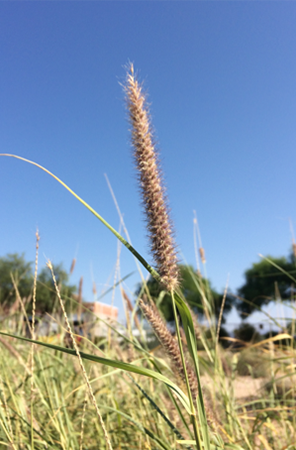
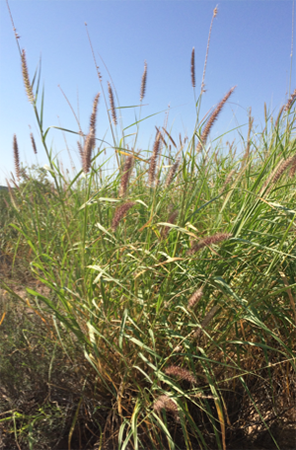
- Common Names
- buffelgrass, pasto buffel, zacate buffel
- Scientific name
- Cenchrus ciliaris
- Growth Form
- Graminoid (grass)
- Inflorescence
- Dense, cylindrical spikes of purplish bristles 0.75-5 inches long (0.25-0.5 inches wide). The bristles are slender and wavy at the upper (distal) half. There are no awns on the spikelets.
- Leaves
- Flat, 3-11 inches long (less than 0.25 inches wide), and scabrous (rough to the touch); hairy ligules (tiny whitish/blond hairs visible at the base of the leaf blade where it diverges from the leaf sheath, which is the portion of the leaf that 'wraps' the stem).
- Growth Habit
- Bunch grass, all stems grow from a knotty base. The tough, clumped plants can grow to over 3.5 feet tall, and mature plants typically grow to 3-4 feet in diameter.
- Roots
- Deep, generally reaching from 6-8 inches into soil.
- Dispersal
- Seeds are readily dispersed via wind, water, animal fur, and on clothing and footwear.
- Growth Period
- Buffelgrass is a perennial grass that grows in areas with warm, frost-free winters and a summer rainy season with 6 to 24 inches of rainfall a year. It typically starts growth in late winter and flowers from spring through fall.
- Habitat
- Road rights-of-way, agricultural areas, disturbed sites, vacant lots, rangelands, grasslands, south, west and east-facing mountain slopes, and riparian zones. Occurs in all soil textures but is most common in sandy soils. Primarily a warm-season C-4 grass, buffelgrass growing below 3,000 feet elevation can green-up and flower after almost any rain event. Buffelgrass does not tolerate extended flooding or subfreezing temperatures for extended periods.
History and Distribution of Buffelgrass
Buffelgrass is native to Africa, Asia and the Middle East. It is one of the many African grasses that have been introduced as cattle forage in tropical and subtropical regions of the world, including the southern United States. It was introduced to the United States in the 1930s for erosion control and livestock forage. It was planted in a variety of locations in southern Arizona from the 1930s to the early 1980s.
Records from natural habitat were sparse until about 1980 when it began a rapid expansion. Few people other than botanists noticed it in Arizona before about 1990. Today it is rare to not see it in the southern half of the state, and expansive infestations are becoming more common.
Throughout its native and introduced range, buffelgrass is cultivated, and it has become invasive in Australia, North and South America, and many islands in the Pacific Ocean (including Hawaii), Indian Ocean and the Caribbean Sea.

Buffelgrass has overtaken this slope in Saguaro National Park West. The buffelgrass in the foreground hasn’t become entirely dormant, while on the slope it has turned the straw yellow color characteristic of dormant buffelgrass.
Correctly Identifying Buffelgrass
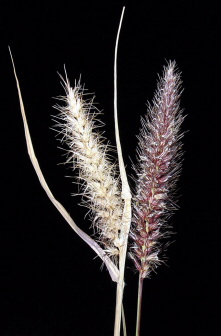

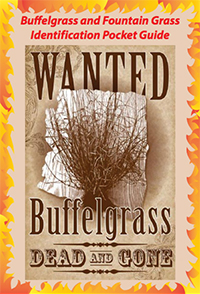
Buffelgrass Identification Pocket Guide
(It’s water-resistant and tear-resistant,
and the pdf looks great on smart phones!)
Before treating buffelgrass, it is important that the plant is correctly identified. A water-resistant and tear-resistant identification guide is available. You can request a copy by email. The guide can also be downloaded as a pdf file. Below are listed some key characteristics.
- bunch grass — all stems come from a centralized point to form a large 'clump'
- color — plants quickly respond to moisture by turning bright green; during dry periods, which means most of the year, buffelgrass is the color of straw
- bottlebrush inflorescence — the seeds develop on the end of a stalk, which has a slightly fuzzy appearance that looks like a bottlebrush
- rough rachis — the central stem that holds the seeds is extremely rough if you run your fingers from the bottom to the top
- hairy ligule — the ligule is the spot where the leaf blade diverges from the stem; delicate hairs are obvious when the leaf blade is pulled slightly away from the stem
- rough leaf blade — the leaf blade contains small stiff hairs so if you run your fingers gently along the blade from the stem to the tip of the leaf it will feel rough
Bottle Brush Seedheads and Rough Rachis: Buffelgrass has a very distinct flower that looks like a bottle brush. The flower can range in color from reddish or purplish brown when seeds are young to a tan color when seeds are mature. Once the seeds have dispersed, the remaining stem (i.e. the rachis) is notably rough.
Although these are some key characteristics that can help in identification, some native grasses have a similar appearance. The best way to learn to identify buffelgrass is to join a buffelgrass pull led by an expert.
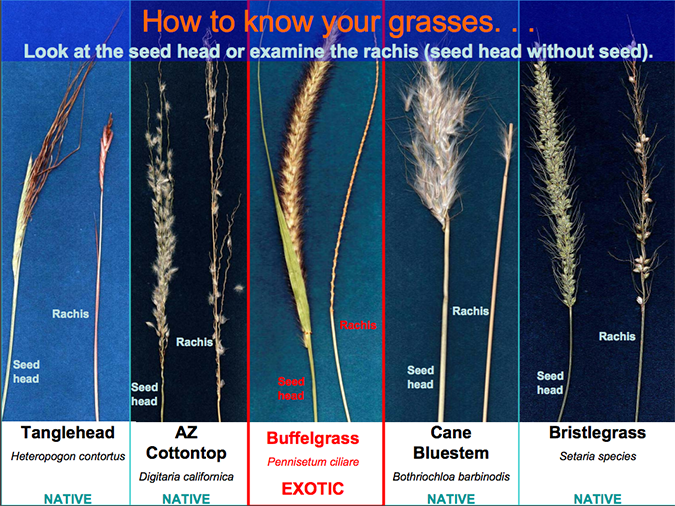
More Buffelgrass Images Here:
Why is buffelgrass a threat?
Increased Fire Severity and Frequency
In southern Arizona, the rapid spread of buffelgrass is transforming fire-resistant desert into flammable grassland.
- Historically, fires in the Sonoran Desert were rare, and only occurred in unusually wet years when winter annuals became super abundant. Scientists estimate these conditions occurred once every 250 years, and even then, fires were small and patchy.
- As buffelgrass becomes more prevalent in the Sonoran Desert, fires will become bigger, more frequent, and more severe. Buffelgrass thrives on fire, whereas the severe fires fueled by buffelgrass kill native plants.
- Buffelgrass is abundant in the wildland-urban interface, creating pathways for wildland fires to enter residential areas. Buffelgrass can also be found in yards, alleyways and utility corridors throughout Tucson.
Loss of Species
Buffelgrass outcompetes native plants for space, water and nutrients. As buffelgrass increases in abundance, native species decrease in abundance.
- Buffelgrass crowds out native plants and puts an end to the spectacular wildflower blooms for which the Sonoran Desert is famous.
- As the abundance of native plants is reduced, there is less food for wildlife, such as the desert tortoise, jackrabbits, and mule deer.
- Loss of saguaros, a keystone species impacts all the creatures that depend on them for food and shelter.
Loss of An Entire Ecosystem
- Even in the absence of fire, the Sonoran Desert is transformed by buffelgrass, from a species-rich desert into a depauperate grassland.
- Fire speeds up this process, as the nutrients released by fire fertilize the fire-adapted buffelgrass, which regrows from its roots while new buffelgrass seedlings establish in the newly opened and fertilized spaces.
Economic Harm
Buffelgrass also poses a serious threat to our regional economy. Tucson attracts millions of tourists every year who contribute billions of dollars to the regional economy. Will Tucson remain such an attractive destination if fire becomes commonplace or if our saguaro “forests” become buffelgrass grasslands. In addition, the costs of buffelgrass-fueled fires will dwarf the costs of controlling buffelgrass. In 2008, an experiment was conducted in the Avra Valley to determine the characteristics of buffelgrass-fueled fire. This video shows how fast and how hot these fires burn.
Controlling Buffelgrass
Mechanical Control
Mechanical control is simply digging it up! Note that mowing, as a stand-alone treatment for buffelgrass control, is not recommended, as it is likely to further the spread of the grass. The choice of tool for digging up buffelgrass depends on the environment. In rough, rocky terrain (eg. the Tucson or Santa Catalina Mountains) a digging bar or pickaxes are essential. In a city park or your own backyard, a shovel may work well.

Digging up buffelgrass results in a large pile of buffelgrass – what do you do with all those buffelgrass plants?! Thatching the uprooted plants over the exposed soil is encouraged and has been shown to inhibit seedling establishment. Thatching simply means layering the pulled plants over the ground where the buffelgrass was uprooted. Care needs to be taken however if pulling along roadside or other areas where piles of buffelgrass could pose a safety hazard. Buffelgrass seeds are viable for 3-5 years, so you must return to your site to deal with the seedlings that will undoubtedly sprout with the next rainfall event. The good news is that seedlings and young plants are much easier to dig up than older, mature plants. Digging up buffelgrass is an effective control method that can be employed year-round on most sites. Of course, the digging is easiest when the soil is moist and temperatures are cool, making the late fall, winter, and early spring months the favored times for this method in southern Arizona.
Chemical Control
Buffelgrass can be controlled with herbicide when the plant is at least 50% green and actively growing. In southern Arizona, buffelgrass usually enters a period of active growth following the onset of the summer monsoons, from late-July to the end of September (and sometimes even through October). All herbicide applications should be conducted as per the labeling instructions.

Regardless of your stance on herbicides, glyphosate is an essential tool for buffelgrass control at this point in time. Scientists are actively working to develop alternatives, but currently glyphosate is the only herbicide that effectively kills buffelgrass, while minimizing effects on non-target plants (native plants). The cost of digging up the the thousands of acres of buffelgrass in remote locations on public lands is prohibitive.
If we choose to do nothing, and allow buffelgrass to spread throughout our public lands, we are choosing to allow our saguaros and other cacti, our palo verde and ironwood trees, our spring and summer wildflowers, and virtually all of our native plants to disappear from these landscapes.
Recently glyphosate (N-(phosphonomethyl)glycine),the active ingredient in many commercial herbicide formulations, has been in the news. Conflicting headlines and the vast diversity of media sources has made it difficult to know which information is accurate, which information is being misrepresented and which information is even relevant. We are offering this list of source materials so that you can read the research and make informed decisions.
Works Cited: Bussan, A.J., and W.E. Dyer. 1999. Herbicides and rangeland. Pp. 116-132. In: R.L. Sheley and J.K. Petroff (eds.). Biology and Management of Noxious Rangeland Weeds. Oregon State University Press. Corvallis, Oregon. 438pp.
Buffelgrass Control Brochures
- Buffelgrass Identification and Treatment Brochure
- Buffelgrass Identification and Treatment Brochure (Spanish)
- Buffelgrass Identification and Treatment Handout
Biological Control
Biological control involves organisms (usually insects, but can include livestock grazing) that are deliberately introduced in an area to control invasive species. The aim of biological control is not eradication, but rather to exert enough pressure on a species to reduce its abundance to acceptable levels (Wilson and McCaffrey 1999).
Buffelgrass is not controlled by grazing alone. If this method of control is used, a combination of other approaches must be used in combination to achieve control. For example, livestock grazing may be useful for stimulating buffelgrass plant growth prior to treatment with herbicide during certain periods of the year when the plant is actively growing. Insect biological control for buffelgrass is currently not available.
Scientists are currently working to develop a “bioherbicide,” derived from fungal pathogens that attack buffelgrass in its native range. These pathogens would not be released into the Sonoran Desert, but rather scientists are attempting to isolate the toxins produced by these pathogens and turn them into a bioherbicide that would be specific to buffelgrass and its close relatives.
Works Cited: Wilson, L.M. and J.P. McCaffrey. 1999. Biological control of noxious rangeland weeds. Pp. 97-115. In: R.L. Sheley and J.K. Petroff (eds.). Biology and Management of Noxious Rangeland Weeds. Oregon State University Press. Corvallis, Oregon. 438pp.
Statutes and Regulations
State
- Noxious weed ruling 2005
Pima County
- Pima County Code of Ordinances Chapter 7.33 - REMOVAL OF RUBBISH, TRASH, WEEDS, FILTH AND DEBRIS (pdf)
- Pima County Buffelgrass (website)
- Buffelgrass Complaint (form)